Key takeaways:
- Community involvement fosters a sense of belonging and encourages collective actions for waste reduction, such as recycling competitions and knowledge sharing.
- Sustainable urban architecture integrates natural elements, uses local materials, and promotes mixed-use developments to enhance community and lower ecological impact.
- Personal initiatives, like eliminating single-use plastics and organizing events, can inspire neighbors and create a supportive environment for waste reduction efforts.
- Community projects, such as clean-up days and garden establishment, build relationships while tackling environmental challenges collaboratively.
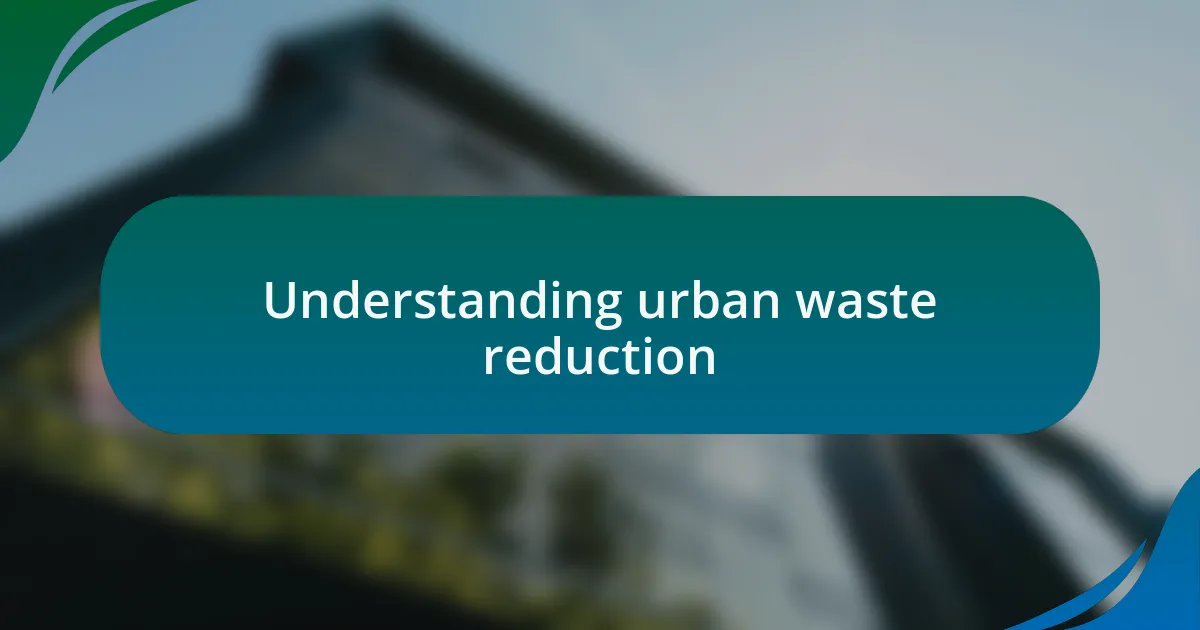
Understanding urban waste reduction
Urban waste reduction is an essential consideration for improving our neighborhoods and overall quality of life. I remember walking down my street and noticing the overflowing bins, and I thought, “What are we really doing to tackle this issue?” This realization sparked my journey into understanding not just the numbers, but also the human behaviors and systems behind waste generation.
On a personal level, engaging with local community members opened my eyes to the challenges many face in reducing waste. I recall attending a neighborhood meeting where passionate residents shared their struggles and successes in composting and recycling. Their stories highlighted that waste reduction isn’t just about the environment; it’s about fostering community spirit and shared responsibility.
As I explored various strategies, I often wondered, what would happen if everyone in my neighborhood committed to this cause? As it turns out, small changes, like starting a community garden or organizing clean-up days, can foster a sense of unity and pride, ultimately making waste reduction a collective effort. Each action creates a ripple effect, inspiring others to join the movement and contribute to a cleaner, more sustainable urban environment.
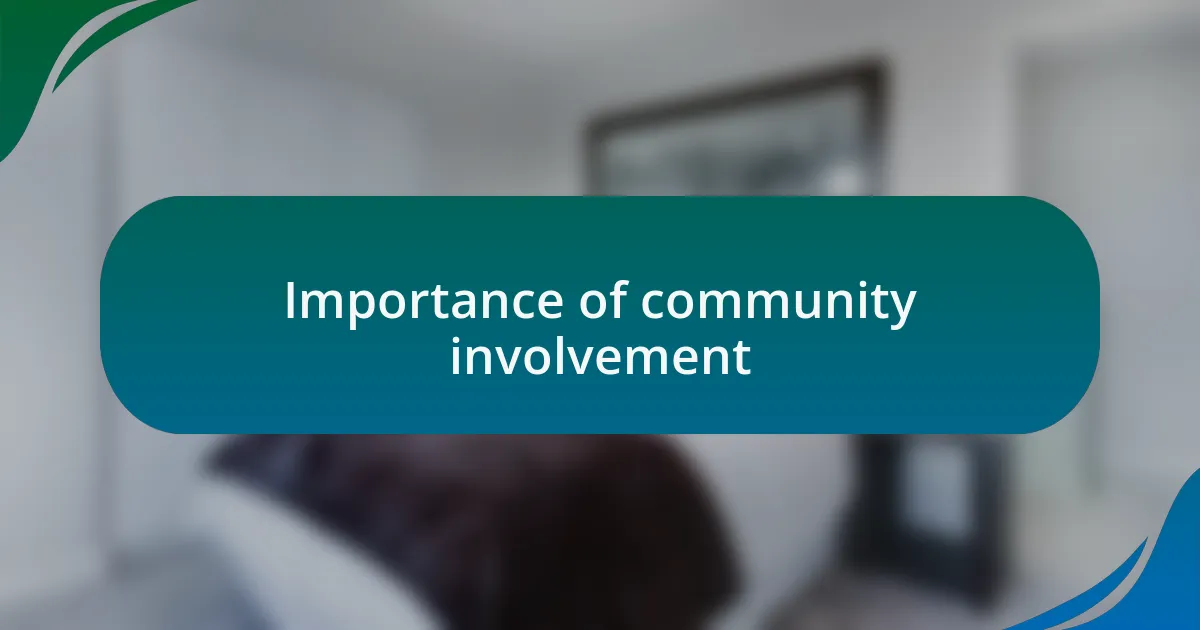
Importance of community involvement
Community involvement plays a vital role in reducing waste and fostering a sustainable mindset. I vividly remember the moment our neighborhood organized a recycling competition. The excitement in the air was palpable, and families rallied together, engaging in friendly rivalry that not only led to more recycled materials but also strengthened our bonds. Isn’t it fascinating how a little competition can transform habits and encourage collective action?
As our community began to take ownership of waste reduction, I witnessed firsthand the emotional investment people had in our initiatives. One neighbor, an elderly woman named Mrs. Thompson, shared how she had been hesitant to start composting but found joy in teaching others. The sparkle in her eyes reflected not just pride in her garden but also a deep sense of belonging. Have you ever noticed how sharing knowledge can uplift an entire community?
Moreover, the beauty of community involvement is that it creates a support system. When one person proposed an idea to host a zero-waste event, others stepped in with their skills and ideas. This collaborative spirit transformed what felt like an overwhelming challenge into something achievable and fun. It made me realize that while individual efforts are important, together, we can ignite a movement, making waste reduction a shared adventure that benefits everyone.
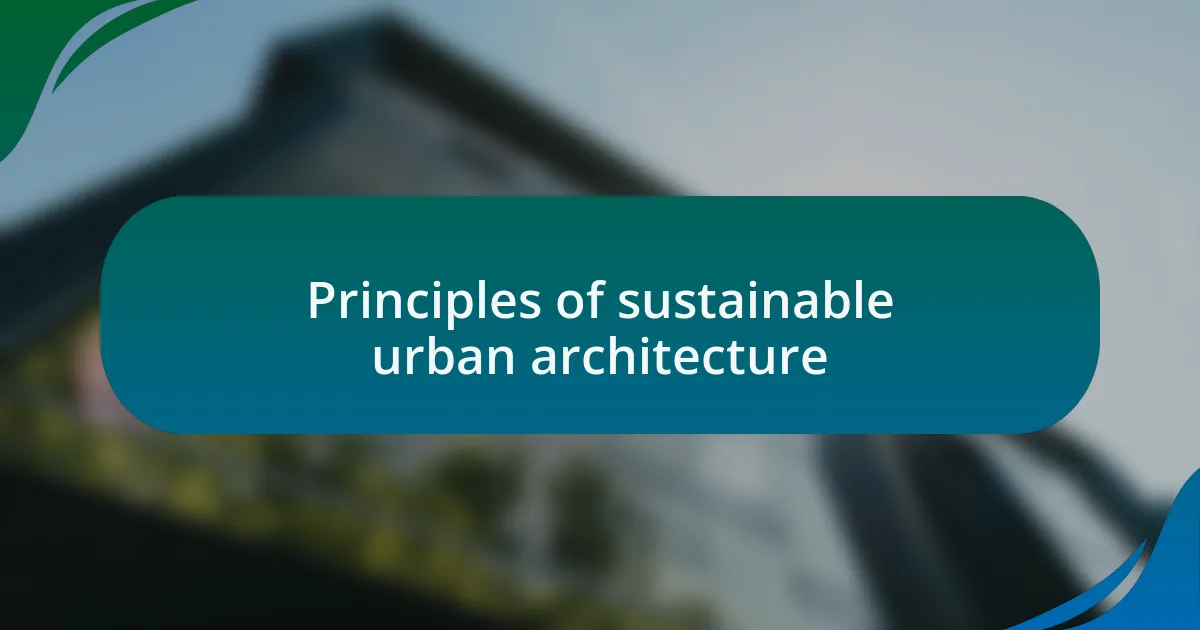
Principles of sustainable urban architecture
Sustainable urban architecture rests on the principle of integrating natural elements into design. I remember how our local park was revamped with permeable paving, allowing rainwater to seep into the ground rather than run off into the streets. This simple change not only enhances flood resilience but also creates a serene space for community members to relax. Have you ever noticed how green spaces can elevate our spirits and foster connections among neighbors?
Another key principle is the use of local materials and resources. Just last summer, we participated in a community workshop focused on utilizing reclaimed wood for building community garden beds. It was remarkable to see how something discarded could be transformed to enhance our shared space. What if every neighborhood could transform waste into beauty?
Lastly, the concept of mixed-use development plays a crucial role in reducing environmental impact. Our neighborhood revitalized an abandoned warehouse into a vibrant hub filled with shops, offices, and housing. The reduction in travel needs was tangible; I often walk to work now rather than drive. Doesn’t it make sense that when resources are consolidated, we uplift the community while minimizing our ecological footprint?
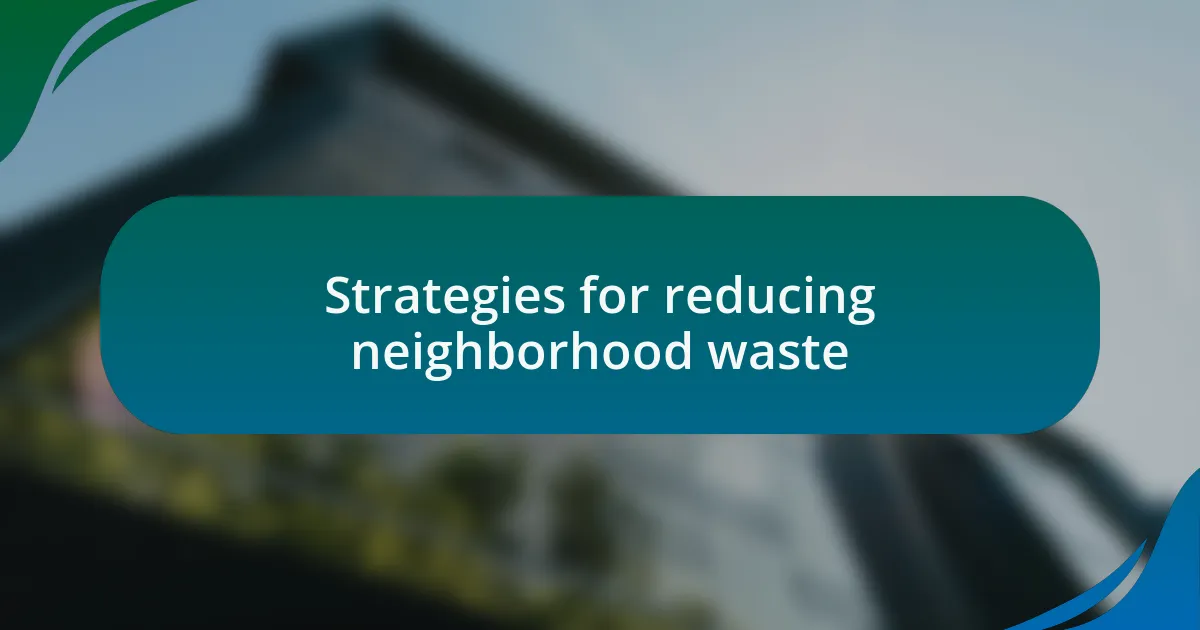
Strategies for reducing neighborhood waste
One effective strategy for reducing neighborhood waste is implementing a community composting program. I recall when our local association introduced compost bins in common areas; it felt empowering to turn kitchen scraps into nourishing soil for our gardens. Have you considered how much organic waste ends up in landfills? By composting, we not only reduce waste but also create a resource that can enrich our environment.
Another approach involves organizing regular clean-up days, where neighbors come together to pick up litter. I remember the energy on that first Saturday morning when we gathered as a community, armed with gloves and trash bags. The teamwork not only beautified our streets but sparked conversations and strengthened our bonds. Isn’t it amazing how a shared purpose can foster a sense of belonging?
Education plays a vital role in encouraging responsible waste management. In my experience, holding workshops on recycling and waste reduction sparked genuine interest in transforming our habits. It’s fascinating how, after just one session, people began sharing tips and resources. Have you ever noticed how enthusiasm can be contagious? The more we learn together, the more committed we become to protecting our neighborhood.
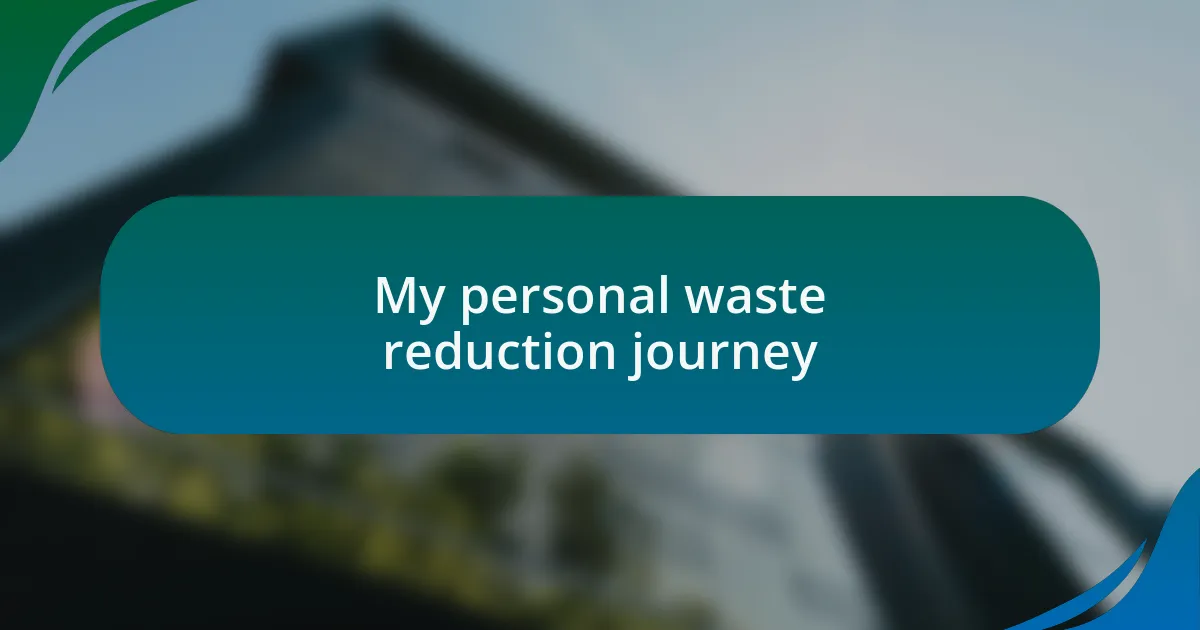
My personal waste reduction journey
The journey of reducing waste in my neighborhood felt deeply personal from the start. I vividly remember my decision to eliminate single-use plastics from my life. It wasn’t just about straws or bags; each time I said no to a plastic item, I felt a small victory. It’s amazing how such choices ripple through our daily lives. Have you ever felt that sense of empowerment from a simple action?
During this journey, I found that sharing my experiences with neighbors made a significant difference. I started small, by inviting a few friends over for a “zero waste” potluck. As we talked about alternatives to disposable items, I was struck by the excitement in the room. Suddenly, it wasn’t just about personal choices anymore; it became a community conversation. Aren’t we all looking for ways to connect over shared values?
Another impactful moment occurred when I organized a neighborhood swap event. I saw firsthand how trading items like clothes, books, and household goods created not only a reduction in waste but also built relationships. The joy of finding someone’s unwanted item was palpable, and watching neighbors exchange ideas for reusing and repurposing was enlightening. Have you experienced the thrill of discovering new possibilities through collaboration? It truly highlights the power of community in our waste reduction efforts.
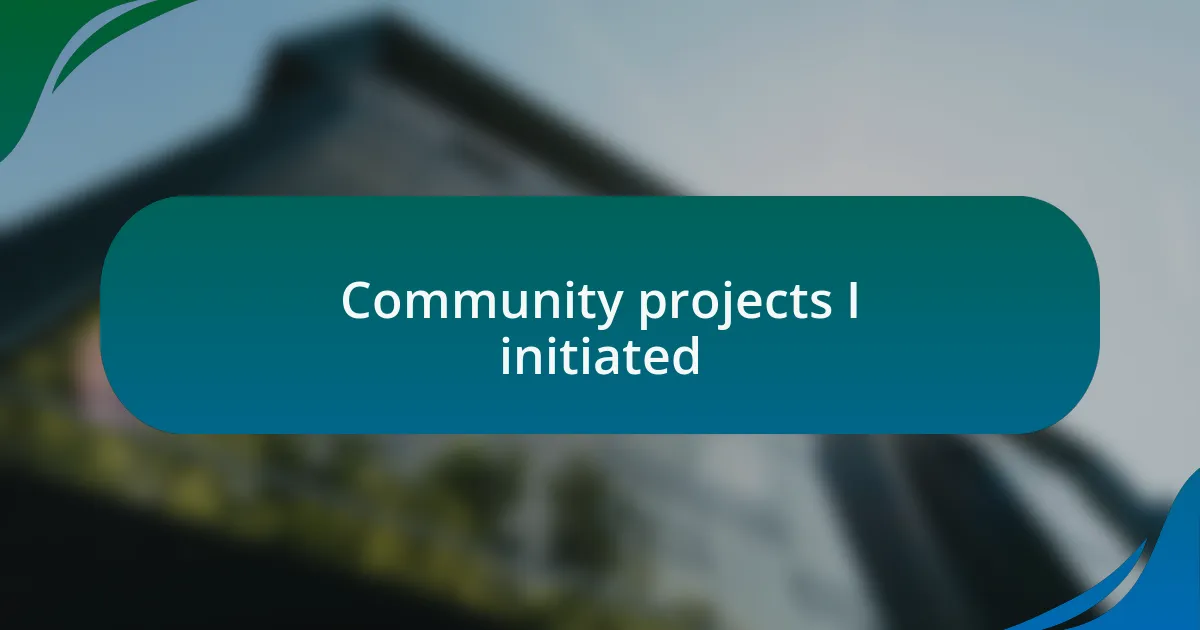
Community projects I initiated
I initiated a community clean-up day that brought together neighbors passionate about keeping our environment green. We gathered early one Saturday morning, armed with gloves and trash bags, and strolled through our local park. It was heartening to see families come out, bonding over a common goal while unearthing not just litter, but also conversations and friendships they never knew existed. Have you ever noticed how a shared goal can spark connections among people?
Another project I spearheaded was the establishment of a community garden. This wasn’t just about planting vegetables and herbs; it transformed a neglected lot into a vibrant space where people could learn about sustainable gardening. I distinctly recall the pride I felt when a neighbor harvested their first tomato, excited to share it with the group. What could be more rewarding than nurturing both plants and relationships simultaneously?
Finally, I arranged workshops focused on DIY projects using recycled materials. These gatherings became a canvas for creativity, as neighbors experimented with turning waste into art, like creating wall decorations from old bottles. The excitement was contagious, and some participants even transformed their experiments into home decor. Have you felt the joy of making something beautiful from something discarded? It’s a testament to how creativity can thrive within a community dedicated to reducing waste.